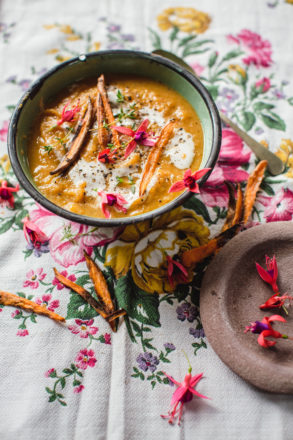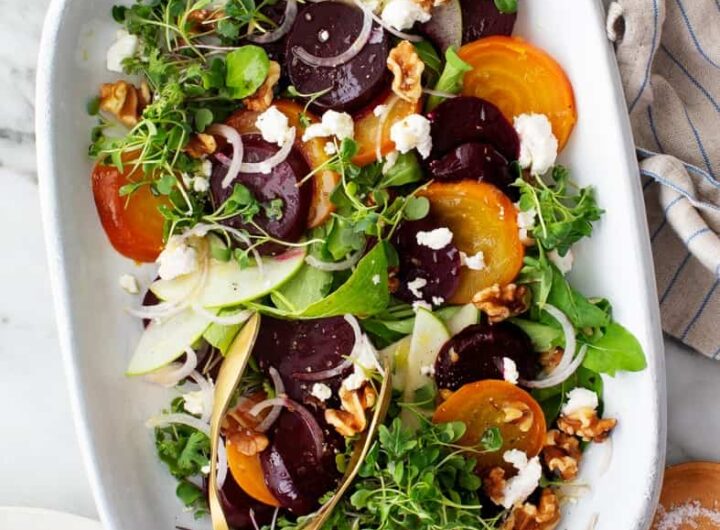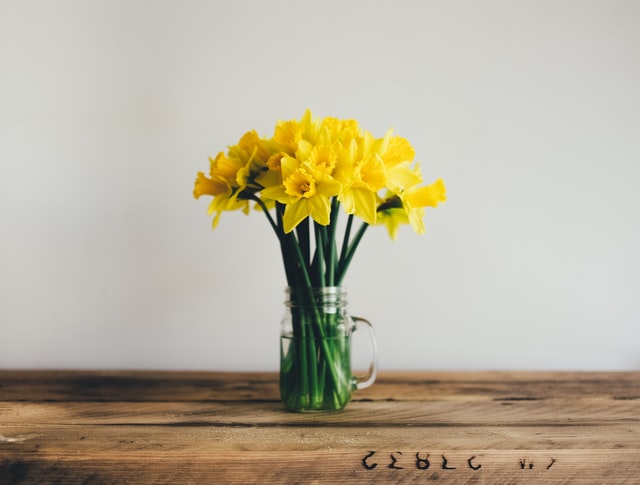

We all know I have a little bit of a green thumb; and love tending to my garden, growing an abundance of herbs, planting new seeds and foraging.
Okay, I know what you’re thinking, isn’t this a blog about prebiotics? And yes, you are right of course.
A few years back in my Gut Health 101, I gave the analogy of the gut as being like an Amazonian rainforest. We’re going to dive a little deeper into that concept today and discuss the gut environment.
Inside each of us is an inner rainforest that needs to be nurtured; this is known as your gut microbiome. Just like a rainforest, your internal ecosystem requires the right soil, seeds, plants and fertiliser to blossom and grow.
To create vibrantly coloured plants, we need a diverse range of bacteria and plant food. This is where varied fibre-rich whole foods come in, known as prebiotics.
Prebiotics are found in your everyday vegetables and legumes such as asparagus, lentils and onion, as well as more exotic foods, like your chicory root and Jerusalem artichoke. They promote the growth of friendly gut bacteria to improve metabolic issues, health maintenance and protection against disorders.
Prebiotics not only have protective effects on the gastrointestinal system but also on other parts of the body, such as the central nervous system, immune system, and cardiovascular system. TAG: triacylglycerol; LDL: low-density lipoprotein; IBS: irritable bowel syndrome; IL-4: interleukin 4; IL-8: interleukin 8; IL-10: interleukin 10; NK cells function: natural killer cells function.

Probiotic foods, like sauerkraut, kimchi and kombucha, are also going to help your inner ecosystem flourish and grow. Probiotics look after the gut by promoting good gut bacteria and ridding the body of any harmful bacteria.
To tend to the rainforest, firstly it needs to be cleaned and free of bad bacteria and residue that inhibits absorption (mucoid plaque). If you’re looking for ways to show gentle cleanse your internal rainforest and sweep out impurities, Love Your Gut Powder, Love Your Gut Capsules and Golden Gut Blend can help. They’re a naturally vegan source of organic quality, food grade diatomaceous earth, that help sweep out impurities and reduce bloating. Golden Gut Blend is a mineral-rich anti-inflammatory blend that helps create a healthy alkaline environment in the body.
It’s time to plant new seeds in your ecosystem, so welcome to the garden club! If you’re looking for a fertiliser, Fulvic Humic Concentrate contains natural plant substances that play an important role in healthy metabolism and gut lining and is particularly useful if you are suffering from increased intestinal permeability (leaky gut). You can read more about leaky gut on Harvard Health here.
Because your bacteria need to be nourished too, today I’m sharing a list of some of my new favourite prebiotic rich foods that you might want to add to your diet for great gut health;
Chicory Fibre
Chicory root is packed with a soluble fibre called inulin, a type of fructan. Inulin can be found in some of our more well-known prebiotics, including artichokes, onions and garlic. Inulin promotes healthy digestion, is excellent for relieving constipation, fighting inflammation and improving the absorption of minerals. Inulin, like all prebiotics, passes through the body undigested, helping to ease digestion. Chicory is commonly added to packaged foods to boost their fibre content, but I think we should dig straight to the source!
While chicory isn’t found in your general grocer, it can be found in some special grocers or health food shops. If you can find chicory root, boil it and then eat the leaves and roots as you usually would eat your greens.
If you’re looking for an alternative to coffee, like dandelion tea, chicory can be used as a caffeine-free alternative and is often combined with dandelion root in tea bags.

It’s seriously delicious, and great for your liver too. You might like to try this Mocha Banana Smoothie Bowl and use dandelion and chicory tea.
Konjac
Used in traditional Chinese medicine as a weight-loss supplement for years, konjac is an Asian root vegetable full of soluble fibre. It contains glucomannan, helping maintain blood glucose levels and relieving constipation while being very low in calories.
While it sounds exceptionally exotic and fancy, konjac can be found as a noodle alternative in the health food section of the supermarket. They make for an excellent pasta alternative for anyone looking to up their fibre, without the gluten, grains or sugar.

Enjoy konjac noodles with vegetables and protein, like my delicious pantry tuna pasta.
Cassava Flour
I’ve always rooted for cassava root! The cassava plant is found in South America, Asia and Africa, and is a starchy carbohydrate, similar to potatoes, taro or yam. The cassava vegetable, also known as yuca, is transformed into an unstoppable flour when we peel and dry it, making it rich in dietary fibre.
It contains a resistant starch known as RS3 and is high in nutrients while being gluten, grain and nut-free. It’s practically the holy grail of gluten-free flours and can be replaced on a 1-1 scale to regular white flour in many recipes.

Why not try this Celeriac Fries recipe and swap it out for Cassava.
Chickpea Flour
Legumes have bean around the town when we talk about prebiotics, so why not spin it around, turn it upside down and process it into flour?
I know, it’s getting wild up in here!
Enter – chickpea flour, the answer to your high-protein flour prayers (just me? Okay, fine.). Chickpeas contain antioxidants called polyphenols, and are rich in protein, containing 20g of protein per cup of flour. It is low GI, meaning it won’t have an impact on blood glucose levels either.

You can typically find chickpea flour (Besan or Gram flour) online, or at a health food store. One of the best ways to use chickpea flour is to turn it into a flatbread called socca bread, which uses a ratio of 1-1 chickpea to water. It’s so chic!
While the prebiotics listed above are a little different to your usual onion and artichoke, don’t be alarmed! The regular vegetables that you’re already buying are already helping to feed your prebiotics and form good gut bacteria; go you good thing!
If you’re wanting some more regular prebiotics to get your inner ecosystem going, I’ve got you covered here too;
I won’t un-leek too many jokes here because I don’t want to bring you to tears ;). Leeks and onions contain inulin, helping to promote healthy gut bacteria and break down dietary lipids.
Leeks and onions are on my weekly shopping rotation, and there’s hardly ever a roast veggie tray in my house without them.

Why not try this one on for size, it’s my popular Prebiotic Tray Bake with Garlic Tahini here.
Still rooting for root vegetables (try to say that ten times fast!)? Me too! I mean, is there anything they can’t do?!
Starchy root vegetables like sweet potatoes, pumpkin, turnips and parsnips are easy-to-digest, great for your digestive system and incredibly cleansing for the body. They tend to be sweet in taste but don’t spike your blood sugar.
They get extra brownie points for being rich in vitamin A and C, essential for our skin and immune health.

If you’re tired of the typical roasted vegetables, try mashing them up in a chunky root veg mash… mmm…
If you’re looking to please even the toughest of critics (in my experience, this is typically children under the age of 12 ha), my sweet potato, broccoli and ham soup is your new go-to. I mean, for real, who can say no to ham?
If you’re going ham just thinking about it, make sure you find a passionate butcher and invest in quality free-range or organic nitrate-free ham. However, if you happen to be cooking for the ham averse, just leave out the ham for a delectable veg-filled soup. I assure you; all taste buds will be singing from the first taste.

Sweet potato, broccoli and ham soup
SERVES 4
This soup is so delicious and easy to throw together. It’s also great to freeze, for use as a quick midweek work meal. In my eyes, ham is one of the most scrumptious, joyous, flavour-filled foods in the world. But not all hams are created equal. Make sure you find a passionate butcher and invest in quality free-range or organic nitrate-free ham, which will be browner and not so pink (pink ham has been treated with nitrates). The taste is second to none, and you only need small amounts to bring an immense salty ham flavour to your meals.
- 1 tablespoon olive oil
- 2 leeks, pale part only, thinly sliced
- 2 garlic cloves, finely chopped
- 4 thin nitrate-free ham slices, chopped
- 500 g (1 lb 2 oz) sweet potato, peeled and chopped
- 1 turnip, chopped
- 1 head broccoli, chopped
- 1 litre (35 fl oz/4 cups) vegetable stock or filtered water
- 2 teaspoons picked thyme leaves, plus extra sprigs to serve
- sea salt and freshly ground black pepper, to taste
- 80 ml (21/2 fl oz/1/3 cup) coconut cream
Method:
Heat the olive oil in a large saucepan over medium heat, then cook the leeks, garlic and ham for 5 minutes, stirring frequently. Add the remaining ingredients except for the coconut cream, then bring to the boil.
Reduce the heat to low and simmer, covered, for 20 minutes, or until the vegetables are cooked.
Transfer half the soup to a blender, allow to cool slightly, then purée until smooth.
Return the puréed soup to the pan to heat through.
Ladle into bowls, swirl in the coconut cream and serve garnished with thyme sprigs and a grind of pepper.
SUPERCHARGED TIP
Roasted sweet potato slices make a lovely garnish for this soup, as do edible flowers. I hope you enjoy it. Let me know what you think of this or any of the other recipes in the comments section below.
 Healthy Eating Nutrition Tips for Busy Lifestyles
Healthy Eating Nutrition Tips for Busy Lifestyles  Tech for a Tranquil Mind – Apps and Devices for Mental Wellness
Tech for a Tranquil Mind – Apps and Devices for Mental Wellness  Is it time to embrace Quiet Living?
Is it time to embrace Quiet Living?  Escaping the procrastination trap-how to start your focus era
Escaping the procrastination trap-how to start your focus era  Managing Type-2 Diabetes
Managing Type-2 Diabetes  The 15-Minute Movement Habit -Simple Desk Exercises for Working Bloggers
The 15-Minute Movement Habit -Simple Desk Exercises for Working Bloggers  Learning More About Magic: The Gathering – Kindred Decks
Learning More About Magic: The Gathering – Kindred Decks  The Most Popular Planes in Magic: The Gathering
The Most Popular Planes in Magic: The Gathering